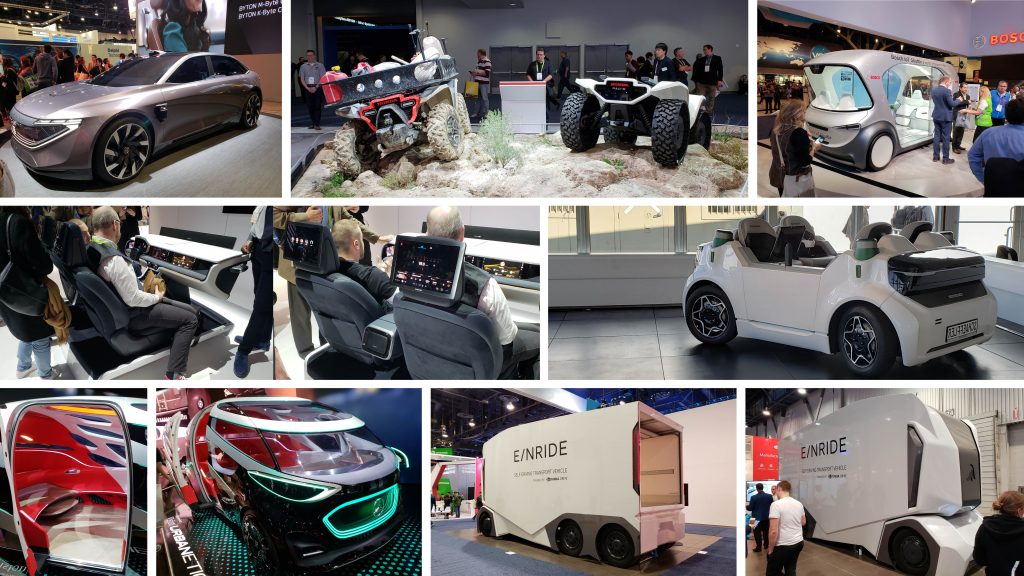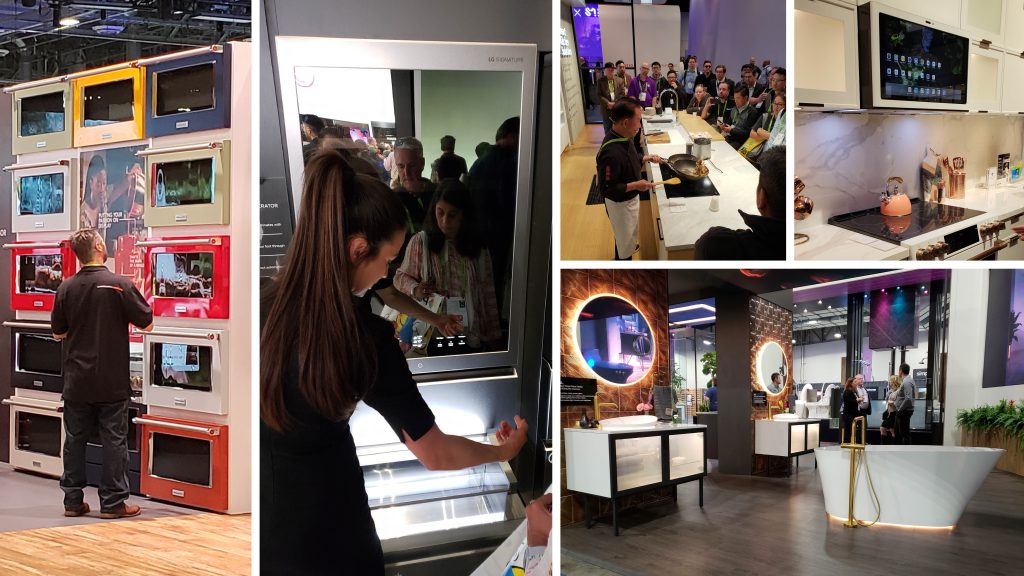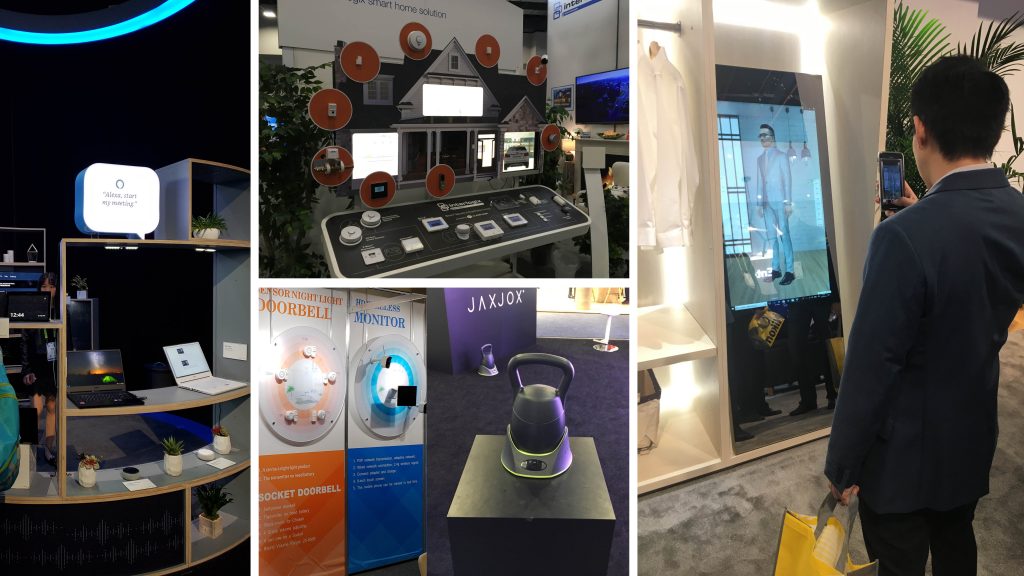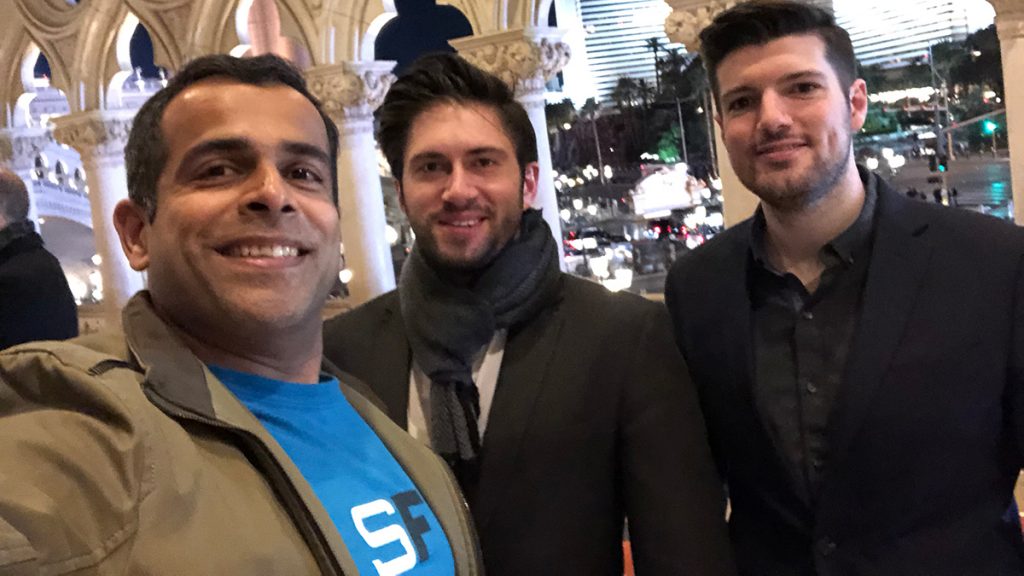
Raw, sun-scorched hills stretched for miles and miles outside our tiny oval window overlooking Nevada as we prepared for landing. The unbroken red-brown topography was interrupted only by the massive solar collection power plants that capture one of the only abundant resources of that state. Before catching the first glimpse of shining Las Vegas, it was hard to believe that this solitary land could contain such an opulent destination city. Not only that, Las Vegas is home to one of the most lavish and emergent showcases and discussion forums of technology and innovation in the world – otherwise known as CES.
For those of us at Sundberg-Ferar experiencing CES once again, it took a moment for us to catch our breath inside the Las Vegas Convention Center. Immediately, a deluge of products filled our field of vision from corner to corner. In the week that followed, we explored the endless hallways of groundbreaking technology, and we now return with insights on how design is acting on the world of tech and what this will mean for our profession in the future. The following is our perspective, as the second longest standing industrial design studio in the nation, on our journey through CES 2019.

Mobility
Anyone experiencing this year’s show could not overlook the overwhelming focus on the future of mobility. Indeed, just as the topic has been the subject of global discussion and debate, the full spectrum of that conversation was manifested at CES. Unprecedented representation from all the major automotive OEMs was a very tangible sign that the mobility discussion is migrating from the forum of the car show to the overall tech show. The definition of mobility continues to broaden beyond the scope of quintessential personal transportation and becomes ever more focused around the myriad technologies being integrated into a connected and unbounded mobility experience.

Furrion made a splash with the only seaworthy vehicle at CES. Their luxury smart yacht was available for tours during the show. Audi cast their vision for the future of driverless cars with their Aicon concept. They also presented a mesmerizing display of paper-thin taillight elements from their A-8. Toyota, in addition to showing their latest work in autonomous vehicle research, brought us on a trip down memory lane displaying a sweet vintage Land Cruiser. Nissan’s I2V concept vehicle helps drivers “see the invisible” and anticipate even what’s around corners or behind buildings through merging information from the cloud and from interior and exterior sensors. Mercedes Benz was breaking necks with their gorgeous EQ “Silver Arrow” single-seat, electric concept car complete with drool-worthy wood and leather interior.
All about Autonomy
Although individual mobility exhibits were as diverse as the category is broad, some common themes were apparent across the spectrum.
To be sure, the race towards autonomy was a repetitive topic. Vehicles with various levels of autonomy for both personal and commercial use were displayed by OEMs and startups alike. Moreover, many of these were ready to be release in the market this year. This amount of incremental and boundary level innovation, dispersed between small and large companies alike, and all presenting viable products is a far cry from what we would have seen at CES even a couple of years ago.
As full autonomy draws closer, companies are also clamoring to convey their vision for the future of shared mobility. From full automotive interiors to HMI and GUI experience design, ride sharing was another topic addressed over and over.

Byton is bringin’ it! The electric car startup turned heads with their “K-BYTE” Level 4 autonomous vehicle. Honda’s autonomous work vehicle used for agriculture, wildland firefighting and solar operations. Bosch brought their electric IoT Shuttle concept that delivers an autonomous, connected, ridesharing experience. Samsung’s showed off their pillar to pillar HMI display in their “Digital Cockpit 2019”. Schaeffler, another electric vehicle startup, unveiled their 2020 Bio-Hybrid passenger vehicle. Mercedez-Benz displayed their flamboyant “urbanetic” driverless vehicle for urban ride mobility. Electric Vehicle startup, Enride is pushing the boundaries in self-driving commercial transportation.
From last mile to last 100 yards
If not addressing autonomy or ride sharing, companies were heavily focused on “last mile” mobility solutions. We saw a proliferation of drones designed to carry out last mile solutions from similar delivery methods to performing inspections on construction sites that are normally perilous for humans.
Sundberg-Ferar also made a definitive statement in the mobility category at CES in helping unveil Hyundai’s walking car concept, “Elevate”. Sundberg-Ferar designed and developed this concept for Hyundai’s CRADLE division as a “Last 100 yards” mobility solution. We presented the concept with Hyundai on stage, including the 1:8-scale robot we developed in-house. This robot is capable of both mammalian and reptilian walking gaits and climbing over obstacles. An impressed CES audience gawked as the robot showed off its mad skills. Elevate is capable of driving to any location like a normal vehicle, but it can then walk or crawl over treacherous terrain or obstacles in the last 100 yards to go where no vehicle has gone before. To learn more about Elevate click here.

(Clockwise) “The Bell of the ball”: The Bell Nexus VTOL Air Taxi stole the show with its imposing presence and reflective black exterior. Sundberg-Ferar’s David Byron presented Hyundai Elevate walking car concept during CES Press Day. Bell also displayed their smaller delivery drone. JD logistics continues to expand their fleet of autonomous delivery drones including this fixed-wing model.
Sensorification
Much of the original equipment at CES was enabled by sensorification technology, and so we saw this undercurrent at work throughout the show. While an omnipresent force behind the products we saw, there were only some exhibits that gave these heros visible representation at the show. Here are some of the highlights that focused on showing their amazing power to advantage.

Velodyn LiDAR presents its powerful portfolio of products for autonomy and driver assistance. FLIR is producing Thermal Vision Cameras said to be capable of predicting and preventing crashes. This “Physical Mirror” gives you almost a full physical using a host of sensor technologies.
Panasonic demonstrated their real-time tracking and projection mapping technology with a Yo-Yo performance from expert Mark Hayward.
Audi flexed their proximity sensing technology with this interactive display.
Smart and Connected Convenience
Much like the mobility discussion, smart appliances were another unmistakable theme this year. It would have been nearly impossible to take in the hallways upon hallways dedicated to smart and connected home appliances alone. Now we are seeing the integration of whole bathrooms, kitchens and homes to become one smart, connected unit. The gamut of the IoT, both now and for the future, was represented at CES. Of course, endless personalization options were part and parcel with almost every user experience we saw within the category.

(Clockwise) KitchenAid’s kaleidoscope of connected ovens. LG presented the future of the smart home including their connected Signature Refrigerator (pictured), and accompanying home appliances. Haier put on a lively demo of their Smart Kitchen Solutions. Café’s smart home connected system. Kohler showed this striking Smart Bathroom Collection using their Kohler Konnect app.

(Clockwise) Amazon displayed their series of connected devices for an all-inclusive home environment experience. Interlogix also displayed their offering of smart home products from garage to kitchen. One of the many smart mirrors that are transforming the retail clothing industry. JaxJox KettlebellConnect lets you add or drop weight faster during your workout with a digital interface. The accompanying app lets you track reps, sets, weights and rest time. A diverse range of intelligent doorbells, monitors and smart home devices by Shenshen Yiroka Electronics Co. LTD.
Big Screens, Minimal Presence
Innovations in big screen technology created some of the most impressive displays at the show. Yet, the impression was made not so much by the screens’ visibility as by their invisibility. Hidden in plain sight, LG’s OLED TV was literally roll-able into a small box. “The Frame”, another of LG’s TVs could transition from entertainment mode to becoming still art on a wall, complete with matte finish and a picture frame. This trend was especially interesting to us since, for the past 20 years, screen design has moved away from the bezel frame. The ideal has been to have as much screen as possible with as thin or non-existent a frame as possible. Over the years we’ve achieved this look by pushing the limits of manufacturing and technology. Now, however, we see a return to the bezel design not because we have to, but because we can.

LG’s “Serif” and “Frame” 4K HDR TV’s brought crowds to their exhibit (top). CHiQ’s big screens integrated seamlessly with surrounding furniture and TV speakers. LG’s show-stopping OLED TV entrance display.
LG Signature rollable OLED TV
AI gains Altitude
Machines that mimic and interpret human behavior and cognition greeted us with friendly faces at CES. With AI replicating the human voice and sounds with sometimes unsettling accuracy, cameras that can determine your emotion, robots that learn our movements in order to dodge around us, delivery “dogs” bringing us our morning paper, or robots with extreme hand-eye coordination, we saw that the future of AI is unfolding here and now.
Each new robot or AI technology is a feat in itself, but we predict more and more widespread use of these technologies in everyday products. Not only that, the technologies being developed in this field today will also springboard the development of even more advanced robots and information sharing between the different types of robots to bring about an exponential acceleration in the field of mapping and replicating human intelligence and behavior.

Honda’s AI-equipped P.A.T.H. bot can move in public places dodging humans and blending seamlessly with their activities. Samsung presents the AI brainpower behind their TVs and sound systems.
Omron’s FORPHEUS robot uses AI coaches humans in skills like playing Ping-Pong using AI.
Return to Analog:
Brand new tech products emerging all over the world are demonstrating a retro-inspired celebration of analog technology in reaction to our increasingly digitized At CES, we saw this theme woven through some of the most popular and engaging exhibits in the show. Still, some these classic tech products were imbued with benefits derived from the digital age such as vast amounts of memory and certain cutting-edge accessories. From Polaroid’s faithful commitment to their original branding and product core competencies to customizable and incredibly cool turntables and retro-inspired sound systems, analog is making a serious comeback.

Polaroid proudly displays its colors for a retro-themed booth. Nikon delivered an engaging hands-on experience with their camera displays. Kharma’s Classique Speakers look like they bounced out of the 90s. Aqua Acoustic Quality’s La Diva CD Transport. Klipsch Heritage Wireless Three Stereo. Bowers and Wilkins 800 Series Diamond. Marshall Stanmore II retro smart speaker, complete with Built-In Alexa. The Döhmann Audio Helix One-V turntable. Nagra’s HD DAC X.
Baby Boomer Design
We were pleased to see a few companies at CES responding directly to pain points of our aging population with products catered specifically to the safety and wellbeing of the elderly. Part of Sundberg-Ferar’s core philosophy is: “Stop being all things to all people. Start by being something to someone.” In this age where there is a very great need for excellent design among some of our population’s most vulnerable, we firmly believe that we owe it to ourselves and to humanity to “be something” for this market segment in particular. At CES, we were very happy to see these products delivering not just the functional attributes, but also the crucial emotional attributes, which we ourselves advocate for here at Sundberg-Ferar. It is this blend of both the functional and emotional that creates usefulness and usability for our aging population and, indeed, any product geared towards a specific user segment.

Robot Care Systems’ Lea Trainer robotic rehabilitation aid. Whill’s Autonomous Drive Wheelchair can be summoned like an uber, giving users an intelligent, personal, electric vehicle experience. Evone’s shoes for independent older adults include a falling alert system while making a fashion statement.
A Sea of Appearance
For all you designers who attended this year’s show, we think it would have been pretty hard to point out a product that looked devoid of a designer’s touch. Whether a produced by a small startup or large OEM, the opposite was actually the case. Most every product we saw made a visual statement, and was attractive in appearance. Thus, we believe we are witnessed the death of appearance design as a differentiator in the global technology market. With every gadget, property and, machine catching our eye through its aesthetic appearance, products will now be forced to compete in more instrumental aspects of design.
Sundberg-Ferar has been a pioneer in the realm of human-centric design since 1934. Over the past 85 years, we have seen the evolution of Western society in recognizing the undeniable benefit of industrial design in the product development process. In fact, Sundberg-Ferar has been a driver of this evolution, proving the value of design by creating uniquely differentiated products that answer user needs and wants while increasing our clients’ profit margins. Now, we believe the next phase in our society’s recognition and use of Industrial Design Thinking is already in motion. Companies will continue to mature beyond their superficial understanding of design as merely a visual aphrodisiac as it becomes a diminishing differentiator in their value proposition. These companies will and are already being forced to rely even more heavily on deeper design tools and insights to drive their future growth.
As the second longest-standing independent industrial design studio in the nation, we know that some pretty sketches and CMF guidelines do not a successful product make. We also know that the beauty of a product is not determined merely by external appearance but by the instrumental value it yields, its usefulness, usability and ergonomics, all in the context of the entire ecosystem in which it exists. We also understand that to make a product truly successful, companies must understand the needs and wants of users that users themselves haven’t even articulated – information that can only be extracted through rigorous design research methodology.
Now that aesthetic design is becoming ubiquitous, companies who wish to become leaders in the tech market will pursue these intrinsic aspects of design. Sundberg-Ferar is thrilled to be in the thick of human-centric design at such an exiting time for the tech world. Everyday, we help our clients by gaining a deep understanding of their target segment, and helping them create authentically unique and compelling products that work well AND look amazing. We firmly believe in the power of industrial design and we use our decades of experience strategically and tactically positioning companies to create sought-after products and services.
B2B2C is the Key
The most effective exhibit design we saw at CES, especially in B2B companies, were those that took the extra step and went from B2B…2C. Through many thousands of projects with OEMs, Tier 1s, Startups and everyone in between, we at Sundberg-Ferar have had first-hand experience working with all the multi-users who interact with a product. B2B products never exist in a vaccum, and as designer, George Nelson, said, “no design can exist in isolation”. To gain a competitive edge in the market, B2B companies must confront this reality.
The most successful showcases at CES were from B2B companies who focused not just on how their products would be useful to their customers, but on how their product will finally be consumed by the end user. Ultimately, every individual at CES, whether designer, manufacturer, researcher, engineer, model maker, or what have you, will be an end user of the tech products displayed. The companies who presented the most compelling story for the end users thought about both: Customers, and end users. By persuading their end users, these companies ended up persuading their customers too.
Bringing it Home

CES 2019 was chalk full of exciting and meaningful products that are changing our world and informing our ideals for the future. Transportation is striding towards full autonomy while also expanding solutions for “last mile” and “last 100 yards”, wherever they may be. Sensorification continues to proliferate. Smart appliances are defining the future of our homes as a digital unit that blends seamlessly into our lives. Big screens will continue to advance their capabilities while minimizing their visible profile. The future of AI and robotics will continue to accelerate exponentially with each new product. In the midst of technology bringing us ever farther from the past we knew, the virtues of analog are being rediscovered. Technologies are targeting the baby boomer generation more and more as the population ages. B2B companies are realizing the importance of designing for all the multi-users in their supply chain, and the primary conveyor of quality in a product will expand from mere aesthetic design into the more instrumental and, we daresay, the more authentic aspects of design.
We came back from CES with a deep sense of gratitude having developed and presented one of the shows most notable and discussion-driving mobility concepts. The show also gave us a wonderful bird’s eye view of the global technology industry. Most of all, we are certain of another exciting and groundbreaking year for the design world, in which Sundberg-Ferar is proud to be an indomitable voice.
Want to talk more with us about CES 2019? Drop us a note at hello@sundbergferar.com!